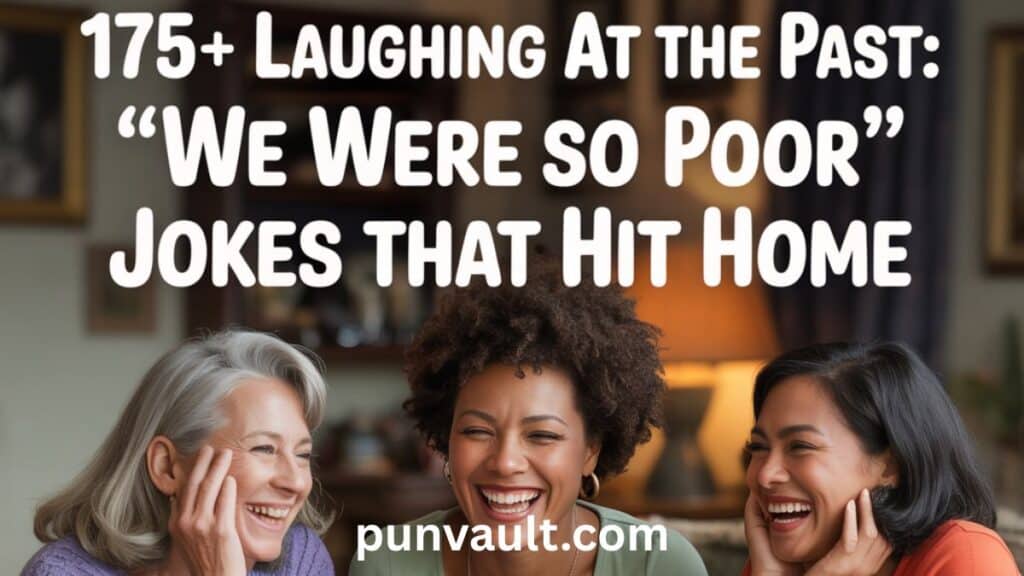“175+ Laughing at the Past: ‘We Were So Poor’ Jokes That Hit Home” is a curated collection of witty, nostalgic one-liners and puns that turn past financial struggles into laughter-filled memories. These jokes highlight moments of hardship through humor, reflecting a shared experience many can relate to while finding light in the darkest times.
Packed with sharp wit and heartfelt punchlines, this compilation transforms scarcity into comedy gold. The blend of clever wordplay and relatable truths makes it an irresistible scroll for anyone who’s ever found joy in making the best of less.
We Were So Poor’s jokes aren’t just funny—they’re stories of survival, resilience, and creativity wrapped in humor, celebrating how laughter can turn struggle into strength.
The Psychology Behind Poverty Humor
Humor in hardship serves as more than entertainment—it’s a survival mechanism. Psychologists have studied how families use comedy to process childhood poverty experiences, and the results are fascinating.
When people share broken humor, they’re not just telling jokes. They’re building bridges. These stories create instant connections between strangers who recognize shared struggles. The tin can telephone becomes a symbol of ingenuity, not deprivation.
Coping with poverty through laughter helps normalize difficult experiences. Instead of dwelling on what families lacked, these jokes highlight what they created. The hand-me-downs become treasured memories. The borrowed sugar transforms into a neighborhood community.
Research shows that humor as a survival actually strengthens family bonds. Children who grow up hearing these stories develop resilience and learn to find creative solutions to problems. They understand that circumstances don’t define character.
The exaggeration in hardship comedy serves a specific purpose. By making situations comically extreme, families can discuss real struggles without overwhelming younger listeners. It’s emotional protection wrapped in punchlines.
Classic “We Were So Poor” One-Liners
Food and Meals
Funny poverty stories about food dominate this category because everyone understands hunger. These jokes turn empty pantries into comedy gold.
“We were so poor, we ate cereal with a fork to save milk.”
“We were so poor, our imaginary dinner guests brought their own food.”
“We were so poor, we had to take turns being hungry.”
“We were so poor, we put a tin can on the table and called it dinner theater.”
“We were so poor, we licked the pattern off the plates.”
“We were so poor, we ate popcorn for breakfast, lunch, and dinner—and called it gourmet.”
“We were so poor, our kitchen sink drip was the family water fountain.”
“We were so poor, we borrowed salt from the neighbors and returned pepper.”
“We were so poor, we reused ice cubes.”
“We were so poor, we had to share a single grain of rice.”
Housing and Living Conditions
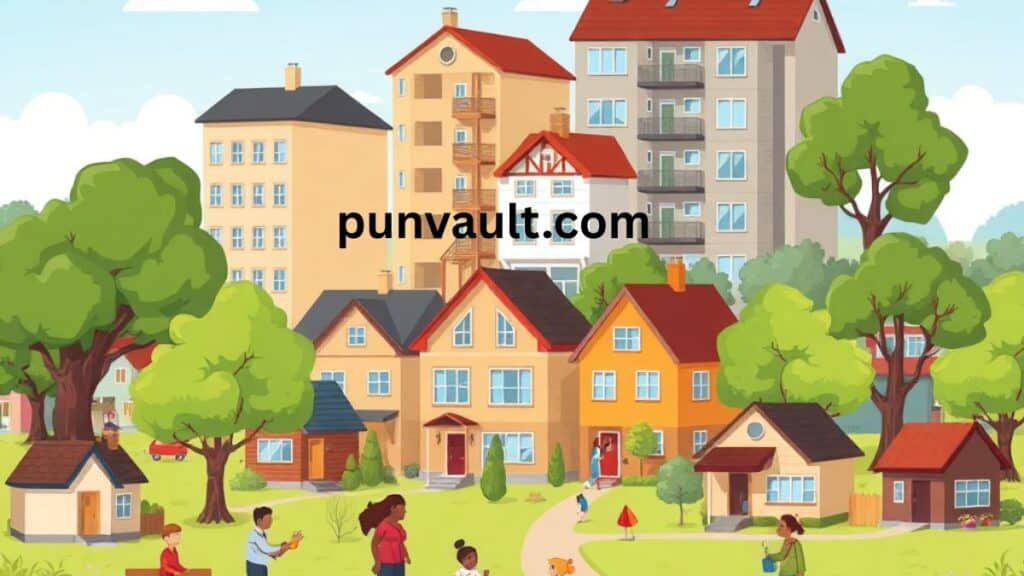
Living situation jokes showcase resourcefulness and creativity in adversity. These one-liners transform cramped quarters into comedy clubs.
“We were so poor, we lived in a cardboard box—and that was after we moved up in the world.”
“We were so poor, we used a rock for a doorbell.”
“We were so poor, our couch cushions were stuffed with hope and pocket lint.”
“We were so poor, we had no AC—just a prayer and a paper fan.”
“We were so poor, we borrowed Wi-Fi from the neighbors and got dial-up speed.”
“We were so poor, our Wi-Fi password was ‘WeCa n’tAffordIt.'”
“We were so poor, we hung a blank frame on the wall and called it our window to the world.”
“We were so poor, we slept on cardboard furniture and called it minimalist living.”
“We were so poor, we had no cellular service inside our house—or outside.”
“We were so poor, we reused the same dream every night.”
Clothing and Appearance
Fashion takes on new meaning when resources are limited. These jokes celebrate hand-me-downs and creative clothing solutions.
“We were so poor, we used socks as mittens and called them ‘sockittens.'”
“We were so poor, we made shoes out of paper bags and called them designer.”
“We were so poor, we shared one outfit—and it was a cardboard box.”
“We were so poor, we wore hand-me-downs from people we didn’t even know.”
“We were so poor, we reused our underwear as outerwear.”
“We were so poor, we had to take turns wearing pants.”
“We were so poor, we made jewelry out of tin cans and bottle caps.”
“We were so poor, we borrowed clothes from scarecrows.”
“We were so poor, our shoes had more holes than Swiss cheese.”
“We were so poor, we used duct tape as a fashion accessory.”
Transportation
Getting around without money requires serious creativity in adversity. These jokes turn transportation troubles into comedy gold.
“We were so poor, we borrowed gas from our neighbor’s lawn mower.”
“We were so poor, we walked everywhere—including to bed.”
“We were so poor, our family car was a cardboard box with holes for our feet.”
“We were so poor, we reused the same mile five times.”
“We were so poor, we took the city bus to our backyard.”
“We were so poor, we used our imagination as public transportation.”
“We were so poor, we hitchhiked to the mailbox.”
“We were so poor, we borrowed directions to our own house.”
“We were so poor, we had to walk uphill both ways—in the same direction.”
“We were so poor, we shared one tire between four wheels.”
Entertainment and Leisure
Finding joy in struggle becomes an art form when families create entertainment from nothing. These jokes celebrate resourcefulness and imagination.
“We were so poor, we played Monopoly with cardboard pieces we made ourselves.”
“We were so poor, we watched reruns of our own lives for entertainment.”
“We were so poor, we borrowed fun from the neighbors.”
“We were so poor, we used a tin can as our gaming console.”
“We were so poor, we reused the same joke until it wasn’t funny anymore.”
“We were so poor, we had to take turns being entertained.”
“We were so poor, we used our popcorn maker as a microwave and entertainment center.”
“We were so poor, we shared one laugh between the whole family.”
“We were so poor, we watched the blank frame on the wall and called it reality TV.”
“We were so poor, we borrowed excitement from our imaginary friends.”
Family-Friendly Clean Poverty Jokes
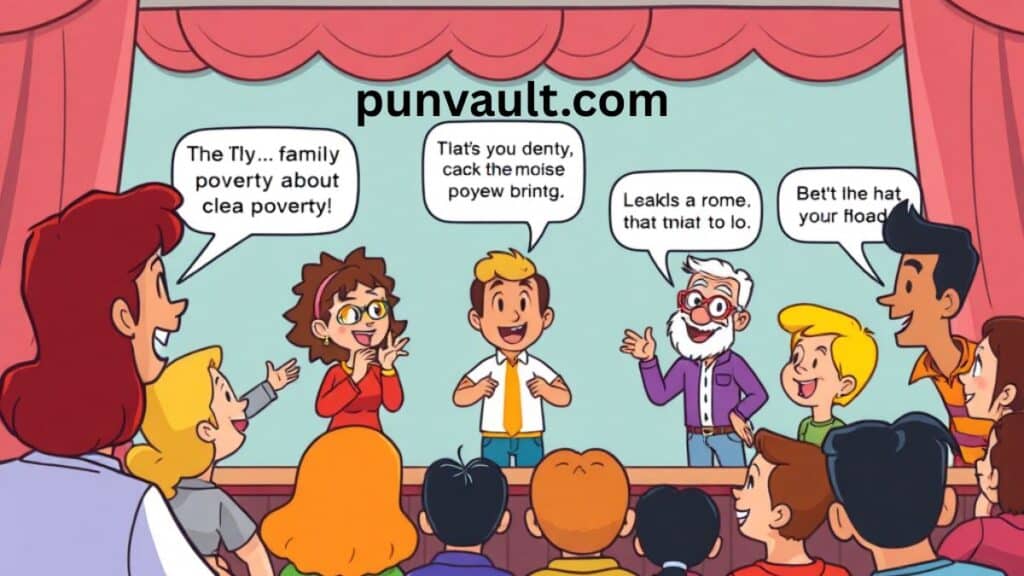
These poor one-liners work perfectly in classroom settings, family gatherings, and workplace conversations. They maintain the humor in hardship while staying appropriate for all ages.
School-Safe Selections:
“We were so poor, we couldn’t afford to pay attention in class.”
“We were so poor, we borrowed pencils from the library.”
“We were so poor, we reused our homework assignments.”
“We were so poor, we shared one backpack between three kids.”
“We were so poor, we used cardboard as our textbooks.”
Workplace-Appropriate Options:
“We were so poor, our budget was more like a suggestion.”
“We were so poor, we borrowed money from our piggy bank’s savings account.”
“We were so poor, we reused our coffee grounds until they were just brown water.”
“We were so poor, we shared one paycheck between the whole family.”
“We were so poor, we used tin cans as our office supplies.”
These clean versions maintain the resilience and creativity in adversity themes while ensuring everyone can enjoy the laughter through struggle.
Regional and Cultural Variations
Poverty humor adapts beautifully to different cultural contexts. Southern families might joke about borrowed sugar and front porch conversations, while urban families reference borrowed Wi-Fi and apartment living.
Southern Poverty Humor:
“We were so poor, we borrowed sweet tea from the neighbors.”
“We were so poor, we reused our front porch stories.”
“We were so poor, we shared one rocking chair between five people.”
Urban Variations:
“We were so poor, we borrowed elevator rides from other floors.”
“We were so poor, we reused the same subway token for a week.”
“We were so poor, we shared one apartment key between the whole building.”
Immigrant Family Adaptations:
“We were so poor, we borrowed the American Dream from our neighbors.”
“We were so poor, we reused our hopes and dreams.”
“We were so poor, we shared one dictionary between the whole family.”
Each culture brings its own flavor to hardship comedy, but the underlying themes of resourcefulness and finding joy in struggle remain constant.
Modern Twists on Classic Themes
Today’s “we were so poor” jokes incorporate technology and contemporary concerns while maintaining their timeless appeal. These updates prove that poverty humor evolves with the times.
Technology-Updated Versions:
“We were so poor, our Wi-Fi password was ‘NoConnection.'”
“We were so poor, we borrowed internet from the coffee shop down the street.”
“We were so poor, we reused the same Netflix password for three years.”
“We were so poor, we shared one smartphone between the whole family.”
“We were so poor, we used cardboard as our tablet screen.”
Social Media Age Adaptations:
“We were so poor, we borrowed likes from our friends’ posts.”
“We were so poor, we reused the same profile picture for five years.”
“We were so poor, we shared one Instagram account between three people.”
“We were so poor, we used tin cans as our podcast recording equipment.”
Millennial and Gen Z Interpretations:
“We were so poor, we borrowed student loan payments from our future selves.”
“We were so poor, we reused our college textbooks as furniture.”
“We were so poor, we shared one avocado between the whole apartment.”
“We were so poor, we used cardboard as our vision board.”
The Art of Timing: When to Use These Jokes
Broke humor requires careful timing and audience awareness. The key lies in reading the room and understanding when laughter through struggle will connect rather than alienate.
Appropriate Settings:
- Family reunions where shared experiences create bonds
- Workplace ice-breakers among colleagues who know each other
- Comedy nights where the audience expects hardship comedy
- Storytelling sessions where nostalgia is welcome
Building Connection Guidelines:
Start with milder, poor jokes to gauge audience reaction. If people respond positively to “we were so poor” setups, you can gradually introduce more elaborate scenarios. The goal is finding joy in struggle together, not making anyone uncomfortable.
Avoiding Offense Strategies:
Never use poverty humor to mock current struggles. These jokes work best when they reference past experiences or hypothetical situations. They should celebrate resilience and creativity in adversity, not belittle genuine hardship.
Celebrity Contributions to the Genre
Professional comedians have elevated financial-struggle humor to an art form. Their contributions help legitimize poverty humor as sophisticated entertainment.
Richard Pryor mastered the art of turning childhood poverty into compelling comedy. His routines about hand-me-downs and resourcefulness influenced generations of performers.
Roseanne Barr built her career on working-class humor, showing how broke humor could resonate with mainstream audiences. Her sitcom normalized hardship comedy for television viewers.
Dave Chappelle demonstrates how “we were so poor” jokes can address serious social issues while maintaining their comedic power. His approach balances humor in hardship with social commentary.
Kevin Hart brings childhood poverty stories to sold-out arenas, proving that audiences crave authentic laughter through struggle. His success shows how poverty humor transcends cultural boundaries.
Creating Your Own “We Were So Poor” Jokes
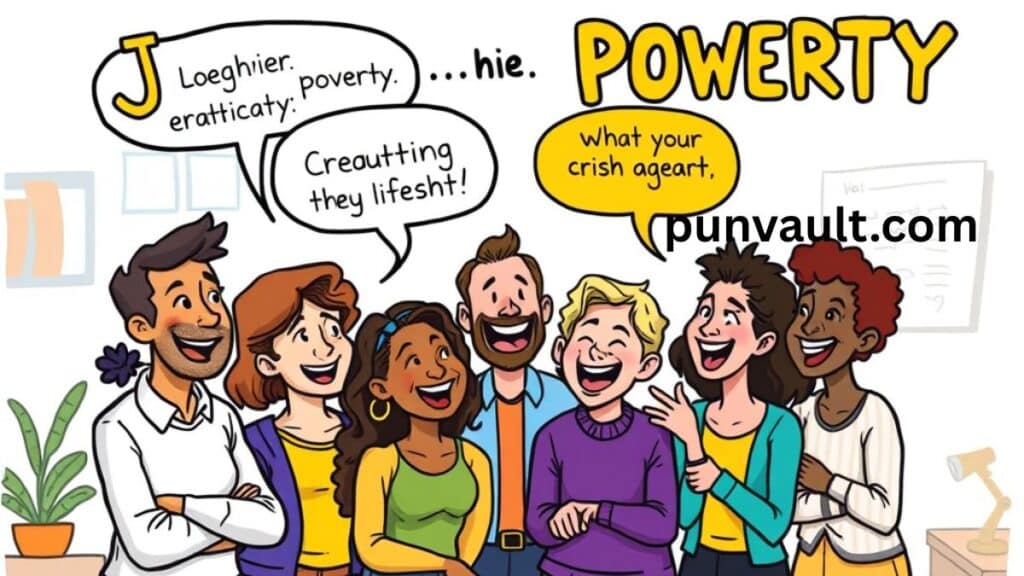
Crafting Effective Poverty Humor:
The formula starts with exaggeration. Take a real situation and push it to absurd extremes. If your family borrowed sugar, imagine borrowing entire meals. If you reused clothes, picture reusing the same breath.
Structure Template: “We were so poor, we [impossible action] and [ridiculous outcome].”
Common Pitfalls to Avoid:
- Don’t target specific groups or perpetuate stereotypes
- Avoid making light of serious mental health issues
- Skip jokes that might trigger trauma for listeners
- Don’t use poverty humor to avoid addressing real problems
Testing Material:
Share your poor one-liners with trusted friends first. Good hardship comedy should generate genuine laughter, not uncomfortable silence. The best “we were so poor” jokes feel both surprising and inevitable.
The Evolution of Poverty Humor
Poverty humor has transformed significantly over the decades. What started as coping with poverty mechanisms in Great Depression families has evolved into sophisticated comedy art.
Historical Context
| Era | Characteristics | Examples |
|---|---|---|
| 1930s-1940s | Survival-focused, literal deprivation | Aspirational, compared to newfound prosperity |
| 1950s-1960s | “We were so poor, we thought TV dinners were fancy.” | “We were so poor, we shared one Walkman between five kids.” |
| 1970s-1980s | Nostalgic, romanticizing simpler times | “We were so poor, we borrowed dial-up internet.” |
| 1990s-2000s | Technology-aware, incorporating modern elements | “We were so poor, we reused the same poverty joke.” |
| 2010s-Present | Self-aware, meta-humor about the format itself | “We were so poor, we reused the same poverty joke” |
Modern Adaptations
Today’s broken humor incorporates contemporary struggles while maintaining classic structure. Student loan debt, housing costs, and gig economy challenges provide fresh material for traditional formats.
Contemporary Examples:
“We were so poor, we borrowed money from our Venmo account to pay our Venmo account.”
“We were so poor, we reused our Netflix password until it became a family heirloom.”
“We were so poor, we shared one delivery fee between three apps.”
The Science of Shared Laughter
Humor in hardship creates measurable psychological benefits. Studies show that families who use poverty humor report stronger bonds and greater resilience during difficult times.
Neurological Response:
When people hear “we were so poor” jokes, their brains release endorphins and oxytocin simultaneously. This chemical combination creates both pleasure and social bonding, explaining why these jokes work so well at family gatherings.
Social Benefits:
- Reduces shame around financial struggles
- Builds community through shared experience
- Teaches creativity in problem-solving
- Develops resilience for future challenges
Therapeutic Applications:
Some therapists incorporate hardship comedy into family counseling sessions. The technique helps normalize struggles while building communication skills.
Building Your Poverty Humor Collection
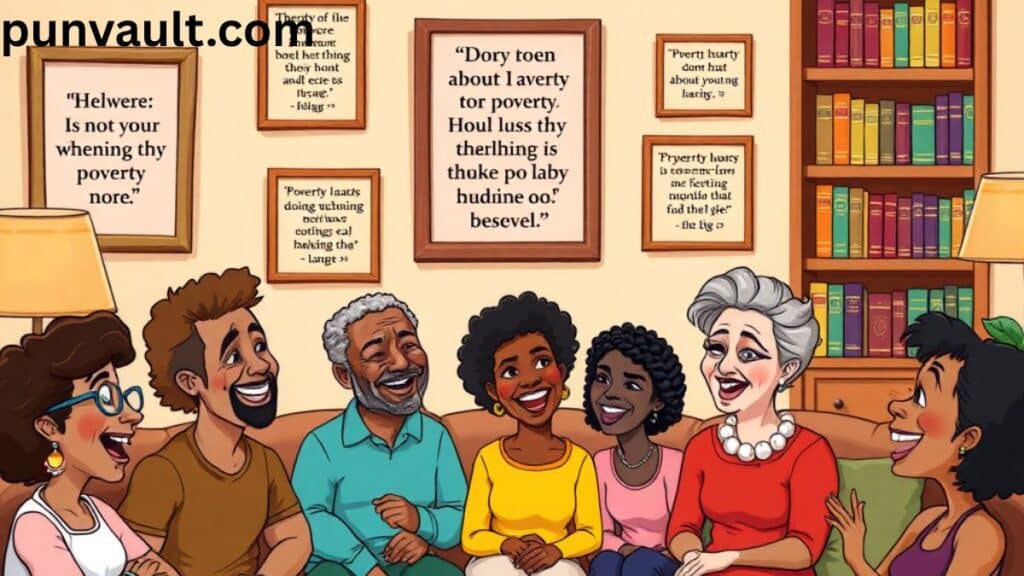
Essential Categories to Master:
- Food and Eating – Universal experiences everyone understands
- Housing and Living – Situations that showcase resourcefulness
- Transportation – Adventures in getting around without money
- Entertainment – Finding joy in struggle through creativity
- Technology – Modern twists on classic themes
Quality Over Quantity:
Focus on poor jokes that feel authentic to your experience. The best poverty humor comes from truth, even when exaggerated beyond recognition. Your cardboard box stories should feel real, even when they’re impossible.
Practice Makes Perfect:
Test your broken humor in low-stakes situations first. Family dinners, casual conversations, and friendly gatherings provide safe spaces to develop your comedic timing.
Advanced Techniques for Poverty Humor
Mastering the Setup:
Great “we were so poor” jokes create vivid mental pictures. When you mention tin cans or cardboard furniture, listeners should immediately visualize the scene. This imagery makes the punchline more powerful.
Timing Strategies:
- Pause before revealing the absurd outcome
- Emphasize key words that enhance the visual
- Build momentum through escalating examples
- Land the punchline with confidence
Audience Engagement:
Encourage listeners to share their own funny poverty stories. The best hardship comedy sessions become collaborative experiences where everyone contributes their favorite poor one-liners.
The Future of Poverty Humor
Emerging Trends:
- Environmental consciousness (“We were so poor, we reused our carbon footprint”)
- Social media integration (“We were so poor, we borrowed influence from micro-influencers”)
- Subscription economy (“We were so poor, we shared one streaming service between the whole neighborhood”)
Technological Evolution:
As AI and virtual reality become commonplace, poverty humor will adapt accordingly. Tomorrow’s jokes might reference borrowed virtual experiences or reused digital assets.
Cultural Shifts:
Younger generations approach financial struggle humor differently than their parents. They’re more likely to address systemic issues while maintaining the laughter through struggle tradition.
Conclusion:
We Were So Poor’s jokes remind us that even hard times can be funny when we look back with a smile. They show how humor can help us cope, heal, and remember the past in a light-hearted way.
These jokes are more than just laughs—they are memories, lessons, and proof of strength. We Were So Poor’ Jokes turn struggles into stories and prove that laughter truly is the best medicine. No matter where you came from, these jokes bring a sense of connection, comfort, and joy.
FAQs:
What are “We Were So Poor’ Jokes”?
Short, humorous one‑liners that exaggerate childhood financial struggles, transforming hardship into relatable comedy.
Why are they so popular now?
They’ve gone viral on TikTok and Facebook recently, with users laughing at shared experiences of scarcity, like using a fork for cereal to save milk.
Are these jokes based on real life?
Yes—many stem from real memories. On a Reddit thread, one user shared:
“We were so poor that momma made us eat cereal with a fork”
How do they help people emotionally?
They offer a way to cope—using humor to reflect on resilience and find solidarity through lace of shared experience.
Where can I share or read more?
TikTok and Facebook have active “We Were So Poor” communities sharing fresh one‑liners weekly.

Abdul Matloob is a wordsmith with a sharp eye for grammar and a playful love for puns. Blending linguistic precision with clever humor, he crafts content that delights language lovers and grammar geeks alike. Whether he’s breaking down the quirks of English grammar or delivering punchy puns that make readers groan and grin, Abdul Matloob turns language into both an art and a game.

